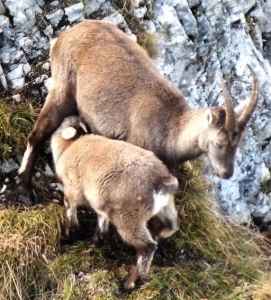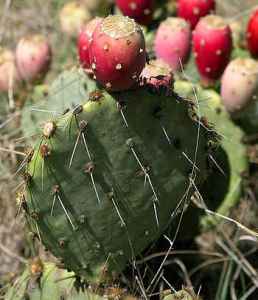Investigations and hypotheses concerning the respective origins of milk and fruit kefir (water kefir or tibicos) grains:
Summary:

 Milk kefir grains and tibicos have generally recognized origins from different sources, respectively domesticated animals for their milk and Mexican opuntia cactus. Both sources being very safe, it is obviously a symbiotic convergent evolution from very different hosts. Several indices tend to imply the following hypotheses:
Milk kefir grains and tibicos have generally recognized origins from different sources, respectively domesticated animals for their milk and Mexican opuntia cactus. Both sources being very safe, it is obviously a symbiotic convergent evolution from very different hosts. Several indices tend to imply the following hypotheses:
- If it is easy to find "wild" fruit kefir grains on opuntia cacti it should be possible to find "wild" equivalents of milk kefir grains in the vital chain of events linking for example a milking nanny-goat with her offspring.
- It should also be possible to prove that the two classes of wild kefir kernels are in probiotic symbiosis with their respective hosts.
- The previous points should allow a better understanding of the respective adoption of kefir grains by the concerned communities for what amount probably to many millennium. Historical improvements (*1) of the domesticated grains is likely to show further adaptations having made them more reliable for the conservation and amelioration of their respective food. (*1) Especially thinking here about milk kefir because of the obvious difficulty to extract the grains from their original environment.
General assumptions:
According to generally accepted knowledge, the history of milk kefir begins in parallel with the domestication of milking animals in mountain pastoral communities (Caucasus, Tibet), which probably places the first voluntary uses of kefir grains several millennia in the past! We can also notice that a mountainous environment is ideal for the conservation of milk at room temperature, leaving more time for experimentation. Water kefir or tibicos meanwhile has a clear origin under the leaves/rackets of the cactus opuntia where according to many experimenters it is possible get the original tibicos grains. Although these two kinds of kefir have totally different origins one can emit several interesting hypotheses:
- Milk kefir grains also have ancestors that can be spotted in the wild in a very similar form, ie a symbiosis of bacteria and yeasts appearing in a macroscopic form.
- This symbiosis has a utility and a symbiotic function that goes beyond the simple survival advantage of the microorganisms concerned.
- Main supposition: the symbiosis of microorganisms constituted by the ancestors of domesticated kefir grains called here wild kefir grains play a role of microbiota for their respective supports. More specifically "wild tibicos grains" probably play an external microbiota role for the concerned cactus and "wild milk kefir grains" probably play an internal microbiota role for the mainly concerned goats and sheep. Note that if this hypothesis proves to be accurate, it reinforces the position of the milk kefir in its regulatory role of the digestive micro-biota of the concerned mammals, since it would have probably evolved for this purpose in a millions of years synergy. It should be noted that the fact that milk kefir grains have been able to participate in the voluntary conservation of milk in pastoral communities for millennia reinforces the idea that these grains are extraordinary, they probably have additional capacity to be optimal in both food preservation and the health of people who drink fermented kefir milk.
- How to confirm some of these theories in an experimental way? For tibicos, the origin is already established and it's likely that without their grains of wild kefir opuntia cacti would be less resistant against pathogenic microorganisms. For milk kefir grains, a crucial step would be to be able to extract wild kefir grains to see whether the resemblance is sufficient for a parallel to be established, and secondly to see if it is possible to convincingly ferment some milk.